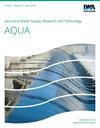Monitoring and prediction of land use/land cover changes and water requirements in the basin of the Urmia Lake, Iran
IF 4.3
Q2 Environmental Science
引用次数: 1
Abstract
As one of the largest super-saline lakes in the world, Lake Urmia in northwestern Iran has been facing severe drying in recent years. Drought and rapid expansion of agricultural activities are considered to be the main driving factors for the shrinking of the lake. To address this problem, an analysis of the spatiotemporal dynamics of land use/land cover (LULC) is important. This research implemented a multi-source satellite image analysis through support vector machine (SVM) for mapping LULC distributions for the years 2000, 2010, and 2020. Cellular automata (CA)–Markov was prepared for modeling the future landscape changes for 2030 and 2040. In the last step, the water requirement of agriculture in the catchment area of the Urmia Lake was simulated through the NETWAT model. Through the employed future LULC modeling, it was found that the areas covered by irrigated agriculture and gardens will grow from 1,450 and 395 km2 to 3,600 and 1,650 km2 in 2040, respectively, as deduced from the changes that occurred from 2000 to 2020. This will increase the water requirement of agriculture from 1,500 billion cubic meters in 2000 to more than 4,100 billion cubic meters in 2040.伊朗乌尔米亚湖流域土地利用/土地覆盖变化及需水量监测与预测
伊朗西北部的乌尔米亚湖是世界上最大的超咸水湖之一,近年来一直面临着严重的干旱。干旱和农业活动的迅速扩大被认为是湖泊萎缩的主要驱动因素。为了解决这一问题,分析土地利用/土地覆盖(LULC)的时空动态至关重要。本研究利用支持向量机(SVM)对2000年、2010年和2020年的多源卫星影像进行分析,绘制了LULC的分布。细胞自动机(CA) -马尔可夫是为模拟2030年和2040年的未来景观变化而准备的。最后,利用NETWAT模型对乌尔米亚湖集水区农业需水量进行了模拟。根据2000 - 2020年的变化,利用未来的LULC模型发现,到2040年,灌溉农业和园林面积将分别从1450和395 km2增加到3600和1650 km2。这将使农业用水需求从2000年的1.5万亿立方米增加到2040年的4.1万亿立方米以上。
本文章由计算机程序翻译,如有差异,请以英文原文为准。
求助全文
约1分钟内获得全文
求助全文
来源期刊
CiteScore
4.70
自引率
0.00%
发文量
74
审稿时长
4.5 months
期刊介绍:
Journal of Water Supply: Research and Technology - Aqua publishes peer-reviewed scientific & technical, review, and practical/ operational papers dealing with research and development in water supply technology and management, including economics, training and public relations on a national and international level.

 求助内容:
求助内容: 应助结果提醒方式:
应助结果提醒方式:


